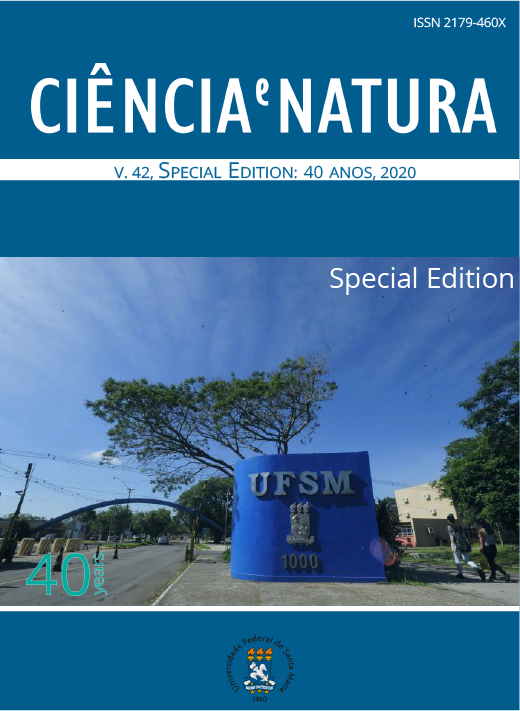Sediment transport for nonuniform sediment mixtures: the Egiazaroff equation and its application in a canyon river in Brazil
DOI:
https://doi.org/10.5902/2179460X39297Palavras-chave:
Transporte de sedimentos, Início de transporte de sedimentos, Equação de EgiazaroffResumo
A compreensão da produção e do transporte de sedimentos é um dos principais tópicos da hidrossedimentologia atualmente. Embora existam diversos métodos para avaliação de início de transporte de sedimentos, o modelo de Shields é largamente utilizado. No entanto, o modelo proposto por Shields pressupõe que os sedimentos apresentam tamanho uniforme em uma mistura homogênea e não-coesa. Como tais condições não são facilmente encontradas na natureza, Egiazaroff propôs um coeficiente de abrigo de sedimentos que considera os sedimentos em uma mistura não-homogênea em uma ampla faixa granulométrica. Esse coeficiente permite corrigir a tensão de cisalhamento crítica de Shields para misturas não-uniformes e pode ser utilizado em rios montanhosos, onde o tamanho dos sedimentos varia em várias ordens de magnitude. A equação proposta por Egiazaroff vêm sendo negligenciada há anos no Brasil, não sendo mencionada nos livros de hidráulica ou hidrossedimentologia. Assim, o presente trabalho teve como objetivo introduzir o modelo proposto por Egiazaroff aplicando esta equação a um rio natural de um cânion no sul do Brasil e indicar o seu uso, visto que os resultados demonstram um bom desempenho da equação.
Downloads
Referências
ANDREWS ED. Entrainment of gravel from naturally sorted riverbed material. Geological Society of America Bulletin. 1983; 94:1225-1231.
ARMANINI A. Principi di idraulica fluviale: Application of Similarity Principles and Turbulence Research to Bed-Load Movement. 2nd ed, Castrolibero: Bios; 2005.
ASHIDA K, MICHIUE M. Study on hydraulic resistance and bed load transport rate in alluvial streams. Proceedings of the Japan Society of Civil Engineers. 1972; 206:59-69.
BRARDINONI F, MAO L. RECKING A, RICKENMANN D, TUROWSKI JM. Morphodynamics od steep mountain channels. Earth Surface Processes and Landforms. 2015; 4(11):1560-1562.
BYRD TC, FURBISH DJ. Magnitude of deviatoric terms in vertically averaged flow equations. Earth Surface Processes Landforms. 2000; 25:319-328.
CARVALHO NO. Hidrossedimentologia prática. 2nd ed. Rio de Janeiro: Interciência; 2008.
CHANSON H. Drag reduction in skimming flow on stepped spillways by aeration. Journal of Hydraulic Research. 2004; 42(3):316– 322.
EGIAZAROFF IV. Calculation of nonuniform sediment concentrations. Journal of Hydraulics Division. 1965; 91:225-247.
EINSTEIN HA. The bed load function for sediment transportation in open channel flows. Technical Bulletin USDA. 1950; 1026:1-71.
HJULSTROM F. Studies of the morphological activity of rivers as illustrated by the River Fyris, Bulletin. Geological Institute Upsalsa. 1935; 25:221-527.
KOMAR PD, LI Z. Applications of grain-pivoting and sliding analysis to selective entrainment of gravel and to flow-competence evaluations. Sedimentology. 1988; 35:681-695.
NAKAGAWA H, TSUJIMOTO T, NAKANO S. Characteristics of sediment motion for respective grain sizes of sand mixtures. Bulletin of the Disaster Prevention Research Institute. 1982; 32:1-32.
OKAZAKI S. A note on the calculation of Egiazaroff for nonuniform sediment concentrations. Science Reports of Tohoku University. 2001; 51:35-44.
PAIXAO MA, KOBIYAMA M. Revelant parameters for characterizing mountain rivers: a review. Revista Brasileira de Recursos Hídricos. 2019; 24:1-13.
SHIELDS A. Application of Similarity Principles and Turbulence Research to Bed-Load Movement. 1st ed. Pasadena; 1936.
VOLLMER S, KLEINHANS MG. Predicting incipient motion, including the effect of turbulent pressure fluctuations in the bed. Water Resources Research. 2007; 43(5):1-16.
Downloads
Publicado
Como Citar
Edição
Seção
Licença
Para acessar a DECLARAÇÃO DE ORIGINALIDADE E EXCLUSIVIDADE E CESSÃO DE DIREITOS AUTORAIS clique aqui.
Diretrizes Éticas para Publicação de Revistas
A revista Ciência e Natura está empenhada em garantir a ética na publicação e na qualidade dos artigos.
A conformidade com padrões de comportamento ético é, portanto, esperada de todas as partes envolvidas: Autores, Editores e Revisores.
Em particular,
Autores: Os Autores devem apresentar uma discussão objetiva sobre a importância do trabalho de pesquisa, bem como detalhes e referências suficientes para permitir que outros reproduzam as experiências. Declarações fraudulentas ou intencionalmente incorretas constituem comportamento antiético e são inaceitáveis. Artigos de Revisão também devem ser objetivos, abrangentes e relatos precisos do estado da arte. Os Autores devem assegurar que seu trabalho é uma obra totalmente original, e se o trabalho e / ou palavras de outros têm sido utilizadas, isso tem sido devidamente reconhecido. O plágio em todas as suas formas constitui um comportamento publicitário não ético e é inaceitável. Submeter o mesmo manuscrito a mais de um jornal simultaneamente constitui um comportamento publicitário não ético e é inaceitável. Os Autores não devem submeter artigos que descrevam essencialmente a mesma pesquisa a mais de uma revista. O Autor correspondente deve garantir que haja um consenso total de todos os Co-autores na aprovação da versão final do artigo e sua submissão para publicação.
Editores: Os Editores devem avaliar manuscritos exclusivamente com base no seu mérito acadêmico. Um Editor não deve usar informações não publicadas na própria pesquisa do Editor sem o consentimento expresso por escrito do Autor. Os Editores devem tomar medidas de resposta razoável quando tiverem sido apresentadas queixas éticas relativas a um manuscrito submetido ou publicado.
Revisores: Todos os manuscritos recebidos para revisão devem ser tratados como documentos confidenciais. As informações ou ideias privilegiadas obtidas através da análise por pares devem ser mantidas confidenciais e não utilizadas para vantagens pessoais. As revisões devem ser conduzidas objetivamente e as observações devem ser formuladas claramente com argumentos de apoio, de modo que os Autores possam usá-los para melhorar o artigo. Qualquer Revisor selecionado que se sinta desqualificado para rever a pesquisa relatada em um manuscrito ou sabe que sua rápida revisão será impossível deve notificar o Editor e desculpar-se do processo de revisão. Os Revisores não devem considerar manuscritos nos quais tenham conflitos de interesse resultantes de relacionamentos ou conexões competitivas, colaborativas ou outras conexões com qualquer dos autores, empresas ou instituições conectadas aos documentos.






